We Got Disc Golf.
Course Design & Installation
Event Coordination & Directing
Neal Dambra - Lead Designer

According to the Professional Disc Golf Association, as of 2024 there are over 10,000 disc golf courses in the USA and another 6,000 worldwide. I have had the opportunity to add a tiny fraction to those 16,000+ disc golf courses over my time involved in disc sports. While my portfolio is relatively small, each course I’ve worked on has a story linking it to the next.
As a lifelong “frisbee” player, I have enjoyed competing in just about all of the widely known disc games. I have participated in over 600 tournament events, mostly in the two most popular disc sports – disc golf, and, when younger, the fast moving team field sport, ultimate. I've been lucky enough to have experienced the complete spectrum of competitor emotions that come from finishing in last place in one event to winning a world championship in another. Mostly, I have been grateful to have a place to throw and catch frisbees with people that share my passion for disc sports.
Yes, I’ve had more than my share of playing time over the decades and still I enjoy competition and the tournament scene – now mostly in the senior age divisions of disc golf. Even with all the countless days and weeks I happily burned competing at disc sport gatherings I have spent even more hours developing spaces and venues in which players meet and compete. This life I have chosen, very often as a volunteer or pro bono consultant, has been fulfilling as any job I could imagine. And my real career (the one that paid the bills) as an art director and graphic designer has been a perfect fit for my course design side gig which involves a lot of conceptualizing, spatial planning and imagination.
"I’m always on the lookout for unusual landforms and natural features to incorporate in a design whenever they present themselves.”
The view from behind the basket as the sun sets on hole #5 at Harvey Penick DGC. You can see the hole in action here during the 2024 DGPT Open at Austin.
Soon after college I moved to Houston, Texas where I joined a very enthusiastic group of disc players called Space City Frisbee. During those early years in Texas I designed several more temporary object courses for club use or specific events including the 1979 Texas State Frisbee Championships held at College of the Mainland in Texas City. That would be the last object course I would design for competition. The newly invented disc golf basket had gained traction and immediately revolutionized the game as well as course design.
After an extended stint focused on the disc sport of ultimate I returned 100% to the disc golf world in the early 1990’s. I became a regular contributing member for the local disc golf club, the Houston Flying Disc Society (HFDS). For over two decades HFDS organized or supported much of the local disc golf activity in the greater Houston area. The club even hosted the Texas State Disc Golf Championships 20+ times and, in a pinch, came through to host the 2002 World Professional Disc Golf Championships. For many of these events I served in different capacities from course manager to graphic designer to assistant tournament director. For the 2008 edition of Texas States (by then a top-tier competition) I was the Tournament Director.
"Occasionally we create special features like this 'sunken ship' green at Cedar Beach. On a windy course like Cedar Beach even a slight bit of basket elevation can add to player focus and course difficulty."
The Town of Babylon Cedar Beach DGC is Long Island’s first ever fully equipped disc golf course. You can read more about Long Island Disc Golf in this Disc Golfer Magazine article written by Neal Dambra.
Texas States 2008 was a spring competition, with 200+ registered players, and was held where I lived on one of the three traditional golf courses at Quail Valley, a southwest suburb of Houston. The project was started in late 2007 and included designing and installing three disc golf courses ready for amateur and top professional play by April of 2008. Although I was the lead designer, I took the time to have each course reviewed early in the design process. I gave hole-by-hole personal tours to some of the area’s best and/or most avid players. They played, vetted the courses and we discussed each hole. Accordingly, design changes were made whenever valid difficulty, safety or technical aspects of the layout were presented. I have always believed collaboration is important to the final result of a course design and I prefer to call myself lead designer instead of the designer.
"I try to make approach throws on long holes as challenging as possible so players don't feel they are simply throwing two drives in a row.
A tee throw finishing in the correct landing zone is rewarded with an approach that looks like this at Heckscher Forest DGC hole 1."
Heckscher Park is the first New York State Park on Long Island to include disc golf in its amenities.
Two of the disc golf courses at Quail Valley, King Quail and Valley Classic would be temporary and set up only for a few weeks including the three days of competition. One of the courses, the Links at Quail Valley, remained in place and was played regularly including PDGA sanctioned events for several years.
The 2008 Quail Valley event was one of the earliest PDGA A-Tier sanctioned events held on a traditional golf course. The track used the terrain and elevation changes typical of a golf course but the flow was radically different with one golf hole usually encompassing two to three disc golf holes. Today, disc golf sharing traditional golf courses, especially for elite events, is fairly commonplace and I like to think the 2008 Texas State Disc Golf Championships was a pioneering milestone in this type of venue for presentation of the sport.
My experience at Quail Valley resulted with a request from the Fort Bend County Parks & Recreation Department to help install a new disc golf course around their Aquatics Center. The park folks had attempted an in-house design which was unrealistic and dangerous since it assumed throwers would throw around trees (rather than over them) like a slalom course. They had purchased the baskets and wanted me to follow their routing and install the course. After reviewing their plan I diplomatically explained why their design wasn’t a good option and declined installation because of safety concerns. I was able to convince them to let me redesign the course.
"Private courses on personal property that aren't built for steady public use don't require formal tee boxes. However, flat, clean high ground that dries quickly is essential."
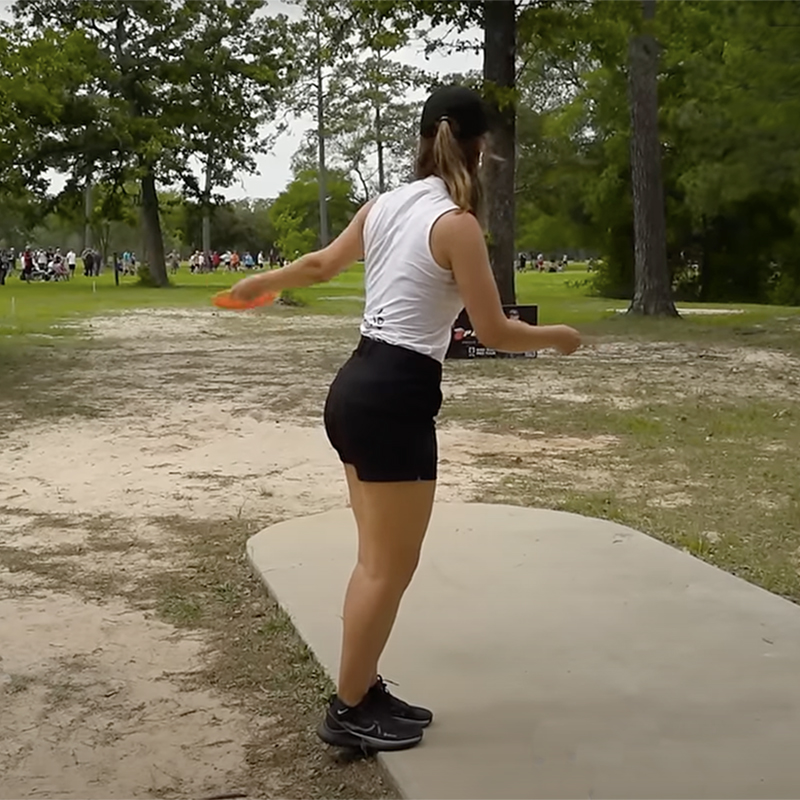
Curved head concrete tee pads, like these designed for Brock Park DGC, allow for nearly 45 degrees of basket movability while using the same tee box. This comes in handy if a basket needs to be moved due to a fallen tree or other factor. You can get a good look at this style of pad on most of the holes being played here. I have designed using concrete, artificial turf, paver tee pads and natural ground depending on the location, budget and course usage expectations.
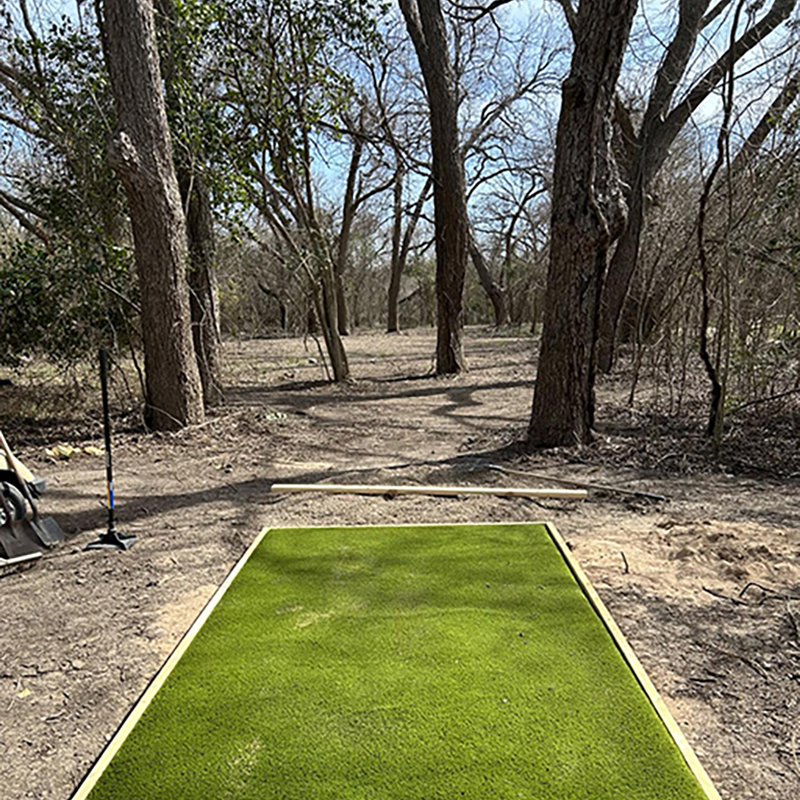
To quick-start a course, artificial turf tee pads are always an option. They are easily built (and moved if necessary) and great for private property courses instead of the more permanent concrete tee pads typically seen in public parks. They can be built many different ways and this video shows one of the optional construction methods.
If You Got Land, We Got Disc Golf!
Special Event? Family Reunion? Corporate Outing? Birthday Party? We deliver fun!
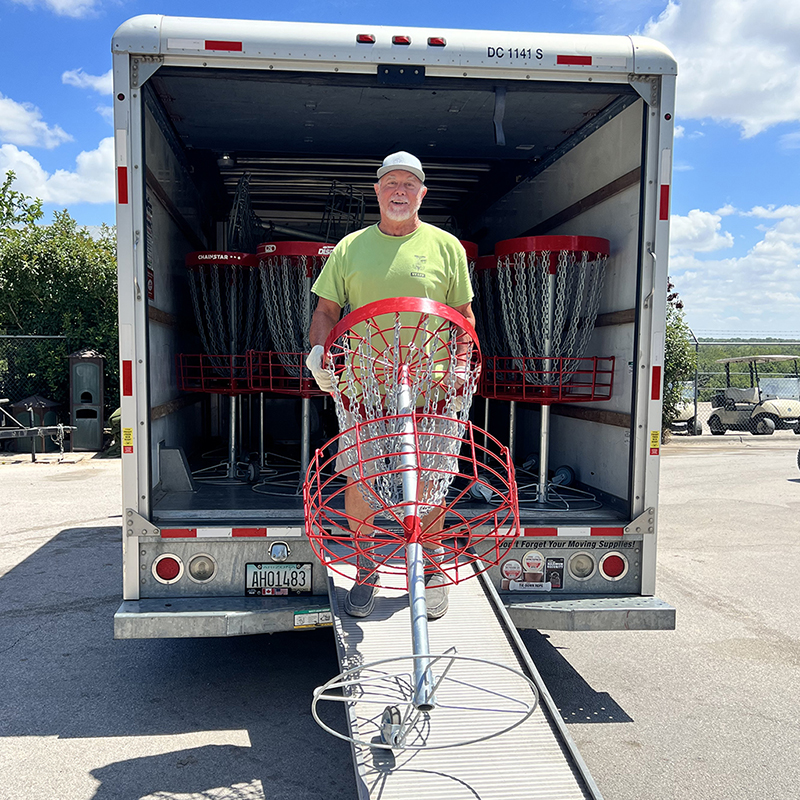
How about adding disc golf to your private affair. Whether on private land or reserved park space, we have the ability to set up a beginner-friendly temporary course from 3 to 18 holes, complete with custom tee signs celebrating your event. Contact Neal Dambra for a quote and to schedule.
"I continue to play and compete regularly. Every round, every throw adds to the overall disc golf experience I refer to when developing a new course.”
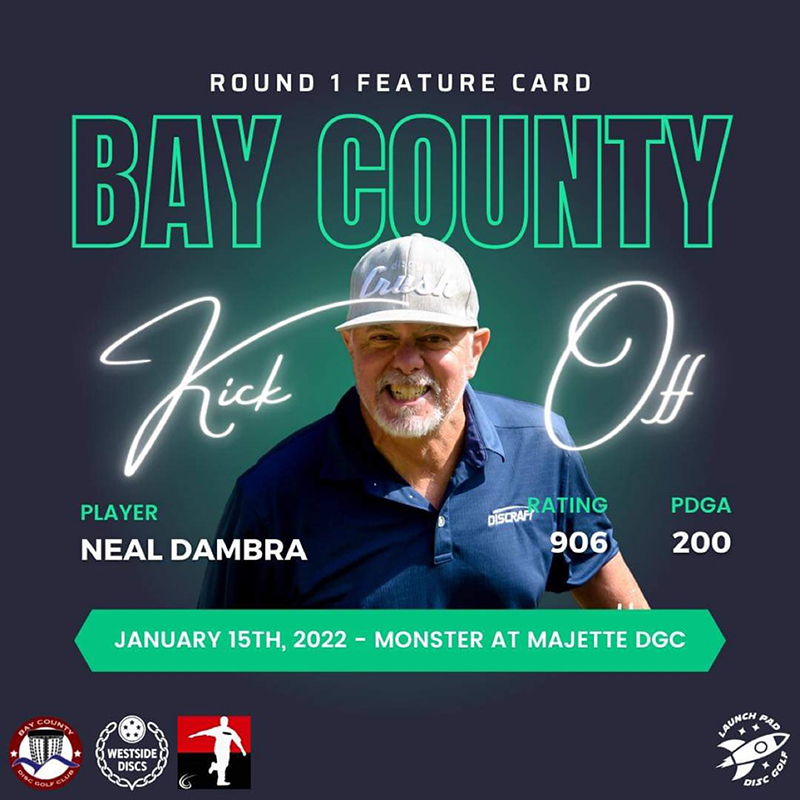
Neal has played in over 320 PDGA competitions since 1991.
Design Philosophy
- Safety: Flight lines, sight lines, relative throwing distances, and warning signs are always a top priority, especially for courses sharing space near other activities like walking, jogging, or bike riding.
- Focus on the overall venue: Parking, restrooms, walking distances, and directional signs always need to be considered upfront and not as an afterthought.
- Who’s the audience: A course might be designed for who will most frequently play there, with distances and difficulty taken into account during planning.
- Go with the flow: Every piece of land has its own natural flow waiting to be discovered. Taking care and time to find the ideal routing is foundational for a good course and should never be rushed.
- Find the alpha hole: Whenever possible, identify a single special spot for a basket position, tee pad or an entire hole and work outwards from there. This “signature hole” doesn’t need to be the first or last hole of a course -- often it's somewhere in the middle of the track.
- Don’t hurry the details: Individual hole detailing and basket location are the icing on the cake. They should be done later in the process to avoid compromising the overall design by premature hole completion.
- Be open-minded: Before a design is finalized, show your plan to disc golfers and consider design alternatives when valid points are presented.
- Keep it fun: Disc golf is a very enjoyable and easy-to-learn game. Any level of course design should try to reflect that aspect of the activity as much as possible.
Notable Disc Golf Courses • Designer / Co-Designer
- King Quail: Quail Valley, TX (2008 Texas State Championship, A-Tier)
- Valley Classic: Quail Valley, TX (2008 Texas State Championship, A-Tier)
- The Links: Quail Valley, TX (2008 Texas State Championship, A-Tier) / Don Wilchek
- Aquatic Park: Fort Bend County, TX / Eric Jubin
- Cedar Beach: Town of Babylon, NY / Ernest Motton
- Heckscher Forest: Heckscher State Park, East Islip, NY / Ernest Motton / LIDG Club
- Dogwood Hills: Woodville, TX (The Open Championship 2015-16)
- Heritage Park: Belton, TX (The Open Championship 2019-21) / Jim Hudson
- Brock Park: Houston Parks & Recreation, TX
- Park Avenue DGC: Belton, TX (The Open Championship Pro Am 2021) / Jim Hudson
- Harvey Penick: DGPT The Open at Austin 2023-25) / Jim Hudson / Jackson Cates / Evan Shper / Jeff Spring
For these and other course projects led by Neal Dambra see the story.
Disc Sports Resume
- Professional Disc Golf Association / Member #200 (1976-Present)
- Texas Disc Golf Hall of Fame / Inducted 2024
- Senior Writer Disc Golfer Magazine
- Founder: The Open Disc Golf Championship – Central Texas
- Co-Founder: The Long Island Open
- Ultimate Players Association (UPA) Executive Director (1990-92)
- UPA Newsletter Producer & Writer (1986-92)
Tournament Director PDGA A-Tier Events
- 2025 DGPT+ The Open at Austin
- 2024 DGPT The Open at Austin
- 2023 DGPT The Open at Austin
- 2022 DGPT The Open at Belton
- 2021 DGPT The Open at Belton
- 2008 Texas State Disc Golf Championships
Competition Highlights
-
A-TIER
- 2008 Stockholm Disc Golf Open / 1st MPG
- 2007 Texas State Disc Golf Championships / 1st MPG
- 2024 20th Annual Greater Hartford Disc Golf Open / 1st MP70
- 2017 Outlaws Round Rock / 1st MPS
- 2016 Outlaws Round Rock / 1st MPG
- 2016 Nick Hyde Memorial / 1st MPS
- 2014 Gentlemans Challenge Las Vegas / 1st MPS
- 2004 Waco Charity Open / 1st MPG
- 2005 Waco Charity Open / 1st MPG OTHER
- 2004 PDGA Professional Disc Golf World Championships / 6th MPG
- 2000 10th National Doubles / 2nd MPM
- 1979 IFA World Frisbee Championships / 6th Disc Golf
- 1980 World Flying Disc Championships / 9th Disc Golf
Compared to the extensive spatial and elevational palette I had while designing the Quail Valley courses, Aquatic Center was the complete opposite. It was a very tight tract of land and the course had to be forced around a large lake running along one side of the park and a residential street along the other. With the lack of options it was my most difficult design to date but it ended up being a frequently played and challenging course. The course was partially redesigned in 2013 by Eric Jubin when the parks dept. added some new land to the footprint and some of the earlier holes were removed.
Besides consulting here and there and helping with changes to some Houston area courses, my next major activity with course development wasn't until 2011. At that point I was heading back to Long Island to spend some time with my mother who was fighting cancer. Although I was still a very active player, I knew there were no disc golf courses on Long Island at the time so before leaving for New York I asked my playing sponsor, Discraft, to please send 21 baskets to Long Island so I could try to get the sport up and running there. I knew I would miss playing regularly and didn't want to travel to Westchester County or Connecticut just to play a casual round.
"I believe someday an entire course will be built with custom designed raised greens and I'd sure like to be part of that project when it happens. Any takers? "
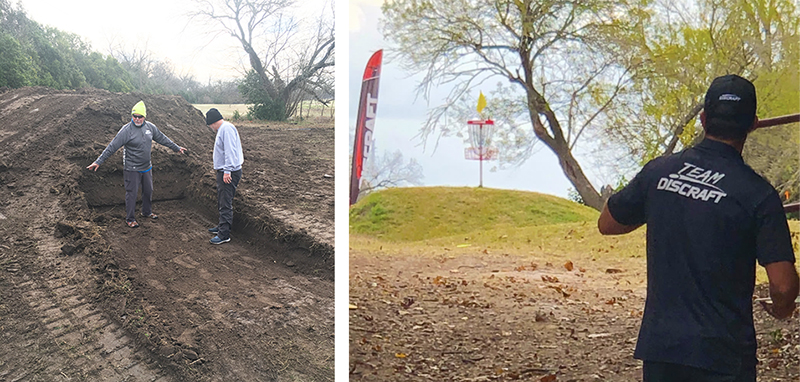

A disc golf course can be built virtually anywhere since the game is played mostly in the air and so it's rare to move a lot of dirt for a course design. But occasionally the opportunity arises to build raised greens which make a course even more interesting. More importantly mounded greens provide for the possibility of radically different basket positions within a relatively small area. You can see these two raised greens in action – Turtle Back hole #4 in Heritage Park and Wedding Cake hole #11 in Brock Park – by clicking on their video link.
When I arrived in New York, 21 Discraft Chainstar baskets were waiting for me in my sister's garage. Soon after arriving I began collaborating with Ernie Motton, a Long Island player also looking for a place to play, and we began searching for a spot to put a course and install the equipment. Local parks people, and most Long Islanders, barely knew about the sport. After months of exploring Long Island for a home for disc golf we finally were able to install a course at the Town of Babylon’s beach golf course - Cedar Beach. Designing on this recreational beach golf course was a new challenge since disc golf was to be played alongside traditional golf. The puzzle was solved and since 2012 Cedar Beach, Long Island's first disc golf course using baskets, has been a pay-to-play seasonal track hosting thousands of disc golf rounds and annual tournaments.
Cedar Beach was a quick start for the game on Long Island but the technology of the sport, specifically disc design, meant it was a very short course compared to most other modern tracks. The search was on for a bigger Long Island footprint and wishes were granted when Heckscher State Park in East Islip accepted our proposal to design and install a championship level 21 hole course on a large parcel of underutilized park space. The baskets were donated by Linda Giordano and with the help of park staff under the supervision of Ernie Motton, Heckscher Forest Disc Golf Course became a reality. The course was a game changer for the sport on Long Island and a strong and well organized club, Long Island Disc Golf, became (and still are) the caretakers of the popular course. In 2024, Hecksher Forest DGC was named one of New York State’s top 5 courses.
"Visualizing what a course will play like when staring through thick growth is a part of the challenge. Accurate visualization leaves the ideal amount of rough remaining around new holes saving construction and installation time."
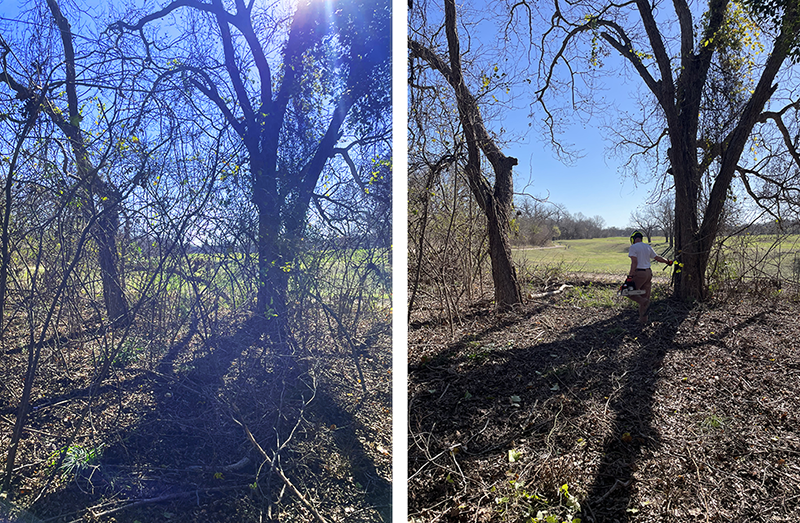
More and more courses are being built on formerly underutilized or discarded spaces where thorny ground cover, vines, brush and competing trees have overgrown for years. Turning these areas into disc golf courses is one of the best ways to use them.
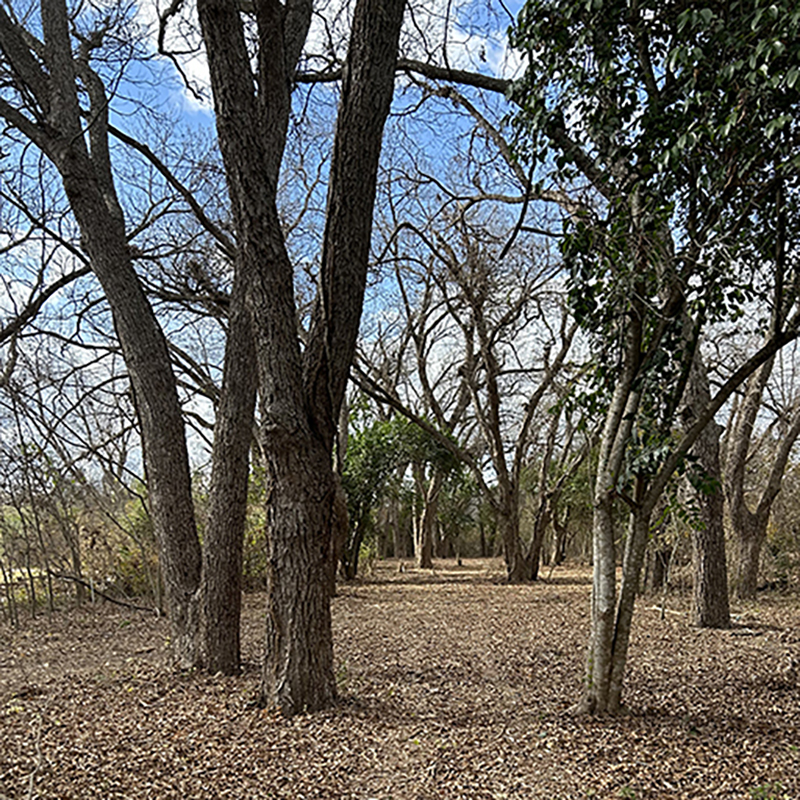
Hole 6 of Harvey Penick after completion of clearing for the 2024 DGPT The Open at Austin.
Soon after Hecksher DGC was completed I returned to Texas with a goal of establishing a new course where I had control over the design and events hosted there. While looking for the opportunity I purchased 21 baskets which I lent out to various events like the 2015 Texas State Championship. Visiting friends in East Texas I often passed an old, privately owned country style 9-hole golf course. Dogwood Hills. One day I stopped in and rented a golf cart and paid the greens fee. I played a round of ball golf with the ulterior motive of checking out the property. It was gorgeous. Lots of elevation, cathedral trees, a creek running through the center, unlimited potential. After convincing management to let me add a disc golf course to the property, Dogwood Hills soon became the site of the first Open Disc Golf Championships – The 2015 Open at Woodville.
As heavenly as it was, a few years after installation, the property owner decided to close the course and harvest the timber. The majestic trees became wood pellets shipped to Europe for heating fuel. We packed up our baskets, signs and tee pad equipment and put everything into storage in Houston until the next opportunity arose.
Meanwhile, The Open Disc Golf Championship was quickly becoming a nationally recognised professional event – and the show must go on. The tournament moved around Central Texas to courses in Temple at Lions Park and to Flat Creek Estate Winery in Marble Falls. All the while the event’s co-director, Jim Hudson, and I were looking for a new spectator friendly home for our course and equipment.
A year earlier the city of Belton had purchased some private land – formerly a traditional golf course – adjacent to its already popular Heritage Park. Jim Hudson lived close to Heritage Park and, along with a few other local disc golf enthusiasts, we proposed to the Belton Parks & Recreation department to allow us to use the newly acquired land on a temporary basis. Belton was planning major amenities for the space but until their plan was ready to be implemented they agreed it was ours to use – as long as we didn’t install permanent infrastructure like concrete tee pads. We developed a solid artificial turf tee pad which we knew would be a good temporary solution and could be disassembled easily. Artificial turf pads, although not practical in some cases, have since become the staple go-to tee pad of the Disc Golf Pro Tour.
The Heritage Park DGC design was geared to accommodate top professional play since exposure of the sport to the world through its best players was our event’s mission. Heritage Park had everything you could want in a course with a wide river on one side and a steep wooded hill on the opposite side. In between was a mixture of long and short holes with sparse trees strategically placed to force shaped throws. With the help of the parks department we were able to design and build two raised greens which added a little more difficulty and spectator interest to some of the more open holes. Unlike building a traditional golf course, disc golf designers rarely get to move large amounts of dirt to detail out a course so the experience was relatively unusual in the disc golf course world.
"It's always great to have the assistance of a parks department or land owner for the initial land clearing. But we don't mind getting our hands dirty."
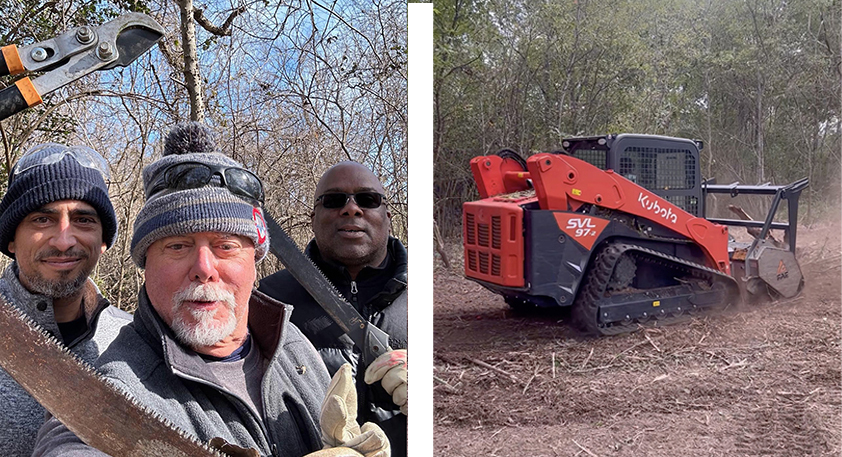
Properly fine tuning a fairway often requires surgical use of hand tools. For preliminary clearing we occasionally contract and carefully direct heavy duty land clearing machinery to get the job done.
"We have the capability to design and install all necessary tee signs, directional signs and kiosks."
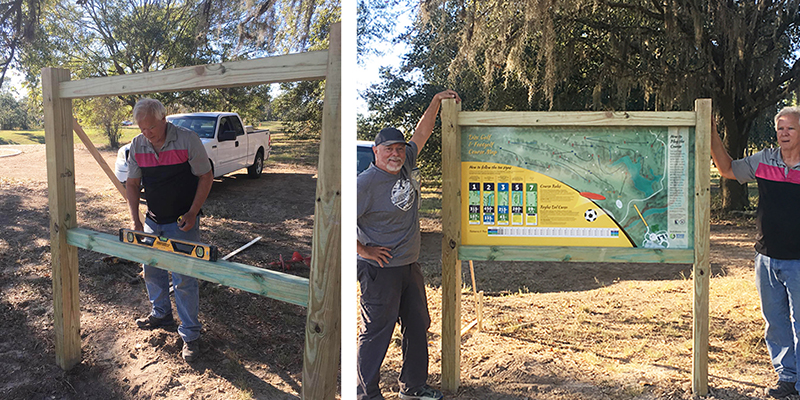
We design and build tee signs, directional signs, warning signs and kiosks to match a park's graphic standards or the personal tastes of the property owner.
Heritage Park was the site of The Open Disc Golf Championship for four years and during that time it caught the attention of the Disc Golf Pro Tour (DGPT). The Open at Belton became a DGPT livestreamed event in 2021 and 2022. During the Heritage Park period I was recommended as a course designer to the Houston Parks & Recreation Department by a disc golfer friend, Kimhak Pech. Kimhak is a longterm HPARD employee and was already known internally there as a top notch disc golfer.
I happily took on the project at Brock Park in East Houston which included course design, supervision, management and installation including tee signs, tee pads and baskets. One more time, this was an out-of-use traditional public golf course getting a complete makeover after a flood had displaced an essential bridge crossing the middle of the property. The plan called for a new bridge, playgrounds, walking and exercise paths, and disc golf. As a master planned project I worked closely with the park’s contracted design company and the course was specified down to the tiniest hardware. Providing that level of information and detail added an aspect of professionalism I had not experienced yet in course design, and I enjoyed the exercise and the increased level of confidence it brought to the overall project.
Brock park DGC was designed in line with the original concept of the park being a neighborhood friendly recreation area. Accordingly, the course was designed as a medium difficulty track to encourage local play. It has a set of beginner level short tees along with longer tees and, by agreement, the routing of the course left a spatial buffer between the playing areas and the surrounding family homes.
The course, including building two new raised greens, was completed and ready for play two years before the park as a whole opened to the public due to unrelated construction delays. Even with the parking lot with bridge access closed the course was still able to gain a regular following with players parking on neighborhood streets and walking in through the open portion of the park and starting play mid course.
Since 2023 the entire park has been granted for a few weeks each year to HFDS and a local disc golf promotion company for use as the venue for the Texas State Disc Golf Championship. An additional pro length temporary course is added to the property by the local organizers, and the original Brock Park disc golf course is modified to accommodate that particular competition.
Back to Heritage Park. The day had arrived when the city of Belton was ready to move forward with their infrastructure plan and The Open DGC, now a pro tour event, had to find a new location. During our search for a venue the Cates family, whose golfing kids were also serious disc golfers, set up a temporary course for a one round competition at the Harvey Penick Golf Campus in Austin, Texas. I was lucky enough to play that day and after walking the property for my round I immediately knew it had huge potential for our elite event. Along with elevation, water features, and wooded areas making for a great course, the venue could also accommodate the several thousand onsite spectators with great views of the competition. After speaking with the course management we worked out an agreement and Harvey Penick DGC had its beginnings as a high profile venue.
Harvey Penick DGC was another new experience for me since it was designed from scratch specifically for a single annual top tier Disc Golf Pro Tour competition. Being a pro tour stop meant live streaming, ticket sales, crowd control, sponsor exposure, vendor areas, parking, restrooms security and other elements had to be factored into planning the course itself. It also means that, as lead designer, I am collaborating with multiple persons who have a vested interest in the success of the event from both a player and fan perspective.
Each year the course is vetted anew and player comments, scoring history and general aesthetics are discussed hole by hole and changes are made accordingly. As we enter our third year the course’s general flow has stabilized and we are enjoying working with detailed adjustments. The flexibility of using artificial turf tee pads (which are essentially portable compared to poured concrete) and having an open mind when it comes to design suggestions means The Open Course at Harvey Penick is a constantly evolving track. Managing that evolution toward the unattainable goal of a perfect course is a new challenge I am thoroughly enjoying in course design. Why would I be enjoying the pursuit of an unattainable goal? Because to me, course design is a form of art and art can never be perfect or it wouldn't be art.
With new projects in the works the story here will continue. Stay tuned or, if you are interested in a course on private or public land, contact me to become part of the story. neal@nealdambra.com
